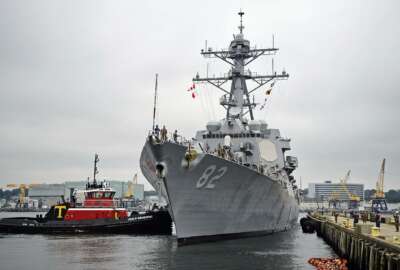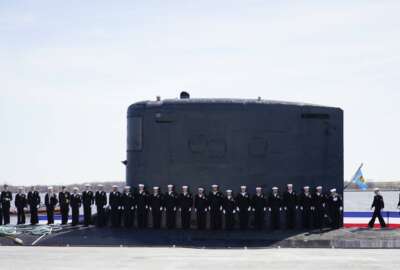How exactly is a stretched-thin Navy doing anyhow?
With conflicts in the Middle East, and having to keep tabs on affairs in the Pacific, the Navy has a hefty to-do list. How is it coping? To find out, Federal News...
With conflicts in the Middle East, and having to keep tabs on affairs in the Pacific, the Navy has a hefty to-do list. How is it coping? To find out, Federal News Network’s Eric White spoke with naval analyst and Hudson Institute Senior Fellow Bryan Clark on the Federal Drive with Tom Temin.
Interview Transcript:
Bryan Clark So the Navy is stressed as you might expect there, because we’ve got forces deployed in the Middle East. Ships deployed and the European theater out in the Indo-Pacific, they’re all facing active adversaries. In some cases, they’re actually being shot at. And maintaining that operational tempo is putting stress on the Navy. Also, the Navy doesn’t have that flexibility to be able to pull ships off deployment for training or maintenance like they might have in the past. Because these operational needs are overriding that. It also means that schedules are being changed. So, you’ve got ships being extended on deployment. That impacts their ability to come home and do the maintenance periods of the repairs that they had scheduled. And so back here in the United States, you’ve got, repair yards, training facilities that are having to juggle their schedules. Which adds to costs, adds to complexity. So, yeah, it makes management of the fleet a lot harder, makes it more expensive, and also from the sailors’ perspective, they’re obviously a lot busier and they’re staying on deployment longer.
Eric White Yeah. You touched on the part I wanted to ask you about next, which is obviously the cost of all of this. This is stretching manpower is one thing. Stretching the dollars to pay them is another. What can? What does the future look like for Navy budgetary concerns now?
Bryan Clark Yeah. So, the Navy is taking these operations out of hide right now. So, the argument would be, well, these ships would be on deployment anyway. We’re essentially just using them for these missions as opposed to doing training or exercises, or whatever they would have done otherwise. But we’re starting to see ships stay on deployment longer than they were intended. We’re seeing ships get deployed earlier. So as a result, we’re burning up a lot of money in terms of just ship operations. And then, like I said, on the back end, what happens is when you’re trying to schedule maintenance, our ship repair capacity is pretty constrained. And so, if you just like if you go to the car shop and your car needs, extra work, you’re going to have to pay extra and somebody else is going to get bumped in order to make that happen. These ships are going to come back. They’re going to need extra maintenance. That’s going to increase costs. It’s going to bump the next ship down the line to later, which means rescheduling and replanning. That creates more costs. So, we’re creating costs across basically every link of the readiness chain we’ve got ships on deployment longer, needing more repairs, creating scheduling complexity creating more costs for, adaptation on the on the maintenance repair side. And then we’re creating a whole set of new needs in terms of training, to prepare ships for the kinds of operations they’re doing now, which might have differed from what they were going to do when these deployments were planned, you know, six months or a year ago.
Eric White You keep on providing me perfect segues, because I wanted to touch on the manpower issue. And, you know, recruitment. We’ve heard from armed services leaders that recruitment has been tricky nowadays. And when people are seeing action, it can sometimes give a little bit of boost to recruitment in the first part. But then as things stretch on, that kind of has an effect on it. Is that what the Navy is seeing right now? Is it in a similar situation as other branches of the military?
Bryan Clark Yeah. So, we just actually did an event with the Marine Corps assistant commandant, and he made the point that the Marines made their recruitment cut quotas. And that’s largely because people believe in the mission. They believe in the culture of the Marines and they’re joining for that reason. So, like you said, in some ways, the current operations are going to be, make it more attractive to join the Navy because you’ll actually go feel like you’re doing something and making a difference. And, you know, in this case, protecting shipping in the Middle East, for example. But you’re right, the stress of know long deployments, you know, going on deployment more frequently, coming home and basically turning right into maintenance as opposed to getting a sort of stand down. Those things are going to really wear on the fleet. And when new recruits are talking to recruiters or talking to people in the Navy, they’re going to get that feedback and that’s going to hurt recruiting. The Navy fell 20% short of its recruiting quota this last year. That’s significant. And I think they might get a little bump, you know, from these current operations. But I think it’s still going to be a really challenging recruiting environment. There are other places to work. Pay is really well, you know, really good in the other sectors of the economy. And the challenge we’re going to see what the Navy probably is going to be increasingly retention. So, retention has been great. You know, the Navy’s had no problem keeping people in. But I think when you get these longer deployments, more frequent deployments, that’s going to cause people to rethink their decision, maybe to go for that next term in the service and look at some of these other options in the commercial sector, which are pretty lucrative and very attractive. Now, if you’re if you’re eligible to serve in the military or you’re already serving, you know, you’re a really attractive recruit for a company that has to try to deal with lots of other, you know, challenges out there in the civilian sector.
Eric White We’re speaking with Bryan Clark. He’s a senior fellow at the Hudson Institute. And yeah, it’s not all doom and gloom. I don’t want to portray it as some sort of dire situation the Navy is facing. So, what are the positives of what is happening right now? At least? You know, the Navy gets to maybe try out some new technologies and look at those future capabilities for, you know, the next battle is they currently testing any new technologies, you know, in the conflicts that they’re dealing with right now?
Bryan Clark Yeah. So, some new technologies are already getting rolled out that might help the fleet. So counter UAS, counter drone technologies. So, like electronic warfare systems, high power microwave systems, which we use around airports and airfields today here, but they haven’t gotten used on ships very much. Those systems are going out there. The idea of using drones to attack other drones, that’s probably going to, you know, get some traction now with the Navy. So that’s a good impetus to bring these new technologies out to the fleet faster. The other thing the Navy’s getting practice doing is just the mechanics of conducting missile defense, because all of our missile defense operations, you know, until recently were exercises so they’re kind of scripted, you know, they’re kind of known quantities. Here you’re putting multiple ships and multiple crews in a position of having to react to an enemy’s attack, even though the attack is with less sophisticated systems, you know, the mechanics and the processes are the same as what you’d use against the Chinese or against the Russians. So that’s really good practice and gets people used to the stress of, you know, a real operation. And also, the, you know, just the mechanics and, you know, human machine interface that has to occur there to make it a successful one.
Eric White Are there any needs that aren’t being met from the ship commanders who are asking for whether it’s finally getting to use the lasers that they’re equipped with, or is there other things that they are desiring to help them fulfill this mission and maybe speed things up a little?
Bryan Clark Yeah, I’d say what commanders are really asking for is a lot more counter drone technology, right. Because we’ve been having to use surface to air missiles to shoot down some of these drones, which the cost exchange is not very attractive from the U.S. perspective. So, you’re shooting down a $10,000 drone with a $1 million missile, which makes sense, because if you’re defending a ship in the Red sea, that cost exchange is worth it. But still, you know, over a long term that’s not sustainable. So, the fleet commanders want to get electronic warfare systems out there like we use ashore, right? When you look at what the Ukrainians are doing to defeat Russian drones, it’s mostly jamming. It’s, you know, jamming the radar, jamming the sensor, jamming the GPS, jamming the communications. And then its high-power microwaves disrupt the electronics on top of those or on those drones. And then it’s, laser systems, you know? So, laser systems are something the Navy has been trying to introduce. I think what the what this might highlight is that the Navy should field the kinds of lasers they can already get access to, which are these, you know, kind of less than 100 kilowatt, you know, models that would really be good against drones but maybe aren’t great for missile defense. And I think that’s where the Navy’s the debate in the Navy has been, is do we wait for a bigger laser that’s able to take down a cruise missile, or do we field a smaller laser today that can take out a drone? And I think what the operations in the Middle East are going to highlight is the fact that we should get those lasers out there more quickly to deal with the drone threat and save us the need to use expensive surface to air missiles to shoot them down.
Eric White And overall, the current state of the US Navy, what sort of metrics are used to measure how well it matches up against other nations navies? You know whether it’s even our allies in Europe or things of that nature?
Bryan Clark Yeah. Well, I mean, you know, I think, you know, fleet size matters because, you know, ships, unlike airplanes, which can move around pretty quickly and are pretty fungible. Ships can only really be in one place at a time. So, you have to have a fleet that’s big enough to like, you see what the US Navy operate in the European theater in the Middle East, in the Indo-Pacific simultaneously. So that’s one measure. And then the other measure might be, you know, how, well, you know, ships are able to conduct offensive and defensive operations. Yeah. If you look at the Chinese navy, for example, which is bigger than the US Navy, most of their ships are really designed for kind of coastal or near shore near seas defense. So, they’re really able to only defend themselves, but they can’t really project power in addition to that. And they’ve got a small portion of their fleet that’s growing that’s intended to do both projecting power offense and defense. So that’s one another thing is, you know, can your ships individually conduct both offense and defense? And then I’d say the last thing is just kind of looking at, you know, how are they going to fight? What’s the are they equipped to do the kinds of operations that you’re likely to have to do? So, for example, the littoral combat ship, you know, was initially not really equipped to do the kinds of operations that the Navy thought it might do, which is sort of escorting ships and protecting sea lanes because it didn’t have enough defensive capacity. So that’s changed. They put some more weapons on them, and you see them now operating in the South China Sea and in protecting sea lanes there and helping allies and partners defend their maritime territory. So, I think that’s the last thing is sort of are they equipped to be able to do the kinds of missions that they’re going to be expected to do? We don’t need a littoral combat ship to be, you know, a destroyer or a cruiser, you know, but it can’t do the things that it’s, you know, meant to be able to do. Well, I think, you know, the other thing that came out of this was sort of the importance of you know, naval aviation, you know, we used a carrier-based aircraft to go attack these, these sites ashore. We’ll probably continue to do that. And now you’ve got a marine Corps, or rather, an amphibious ship in, in the, eastern Mediterranean that’s deploying Marine Corps F-35s, and they’re able to continue that, carry that fight. But, in this case, you had a lot of countries that are sort of sitting out, you know, this confrontation because they don’t want to get on the wrong side of either Israel or the Arab community. And so, the US has to depend on these naval aircraft,,, to be able to conduct operations, because that’s the only base that’s got they’ve got access to. So really highlighted the importance of naval aviation and the need for the Navy to really think about how to create a sustainable mix of aircraft over the long term, because the F-35 is pretty expensive, expensive to operate. The new aircraft they’re pursuing might be even more expensive.
Copyright © 2025 Federal News Network. All rights reserved. This website is not intended for users located within the European Economic Area.
Tom Temin is host of the Federal Drive and has been providing insight on federal technology and management issues for more than 30 years.
Follow @tteminWFED
Eric White is news anchor and Federal Drive producer at Federal News Network.
Follow @FEDERALNEWSCAST







